Model for 400 kV Transmission Line Power Loss Assessment Using the PMU Measurements
Abstract
:1. Introduction and Motivation
2. General Aspects of 400 kV Transmission Line Losses
2.1. General Classification of Losses on Transmission Lines
2.2. Theoretical Background for Losess Calculation on Transmission Lines
2.2.1. Joule Losses
2.2.2. Corona Losses
2.2.3. Leakage Losses
2.3. Histroical Analysis of Losses in 400 kV Grid
3. Proposed Novel Method for Loss Assessment
3.1. Advanced Protection Functions of the WAMPAC System
3.2. Algorithm for Line Differential Protection
3.3. Corona Conditions on 400 kV Line Recorded by Line Differential Protection Using PMU Meassurements
4. Proposed Model for Collection and Processing of Data and Calculation of Losses
- measured load on the OHL;
- historical data on the OHL;
- comparison of estimated and measured data;
- monitoring of the element efficiency of the network;
- weather conditions measurements;
- historical data for each line separately;
- analysis of measured data and statistical error and detection of measurement errors;
- measured and calculated/estimated data on lines from historical data depending on weather conditions.
4.1. Data Collecting Functions of the Proposed Model
4.1.1. Electricity Billing Meter Data (ADVANCE)
4.1.2. PMU Device Data
4.1.3. SCADA System Data
4.1.4. Power Quality Monitoring Systems Data
4.2. Losses Calcuation Function of the Proposed Model
5. Model of 400 kV OHLs for Loss Assessment
5.1. Croatian 400 kV Transmission Grid Main Chacteristics
5.2. Losses Calculation in Existing Metering Systems
5.3. Loss Calculation with PMU Measurements
5.4. Wheather Forecast Input for Losess Planing
6. Assessment of Losses from Metering and PMU Devices on 400 kV Lines
7. Measurement Results
7.1. Forecast and Measurement of Rain
7.2. Prediction of Losses and Measurement on 400 kV
7.3. Comparing Losses with Weather Measurments
8. Applicability of Proposed Loses Assessment Model and Results
9. Conclusions
Author Contributions
Funding
Institutional Review Board Statement
Informed Consent Statement
Acknowledgments
Conflicts of Interest
References
- 2nd CEER Report on Power Losses, Council of European Energy Regulators asbl, Cours Saint-Michel 30a, Box F–1040 Brussels, Belgium. 2020. Available online: https://www.ceer.eu/report-on-power-losses1# (accessed on 2 September 2021).
- Sivanagaraju, S. Electric Power Transmission and Distribution; Pearson Education India: Andhra Pradesh, India, 2008. [Google Scholar]
- Hu, J.; Harmsen, R.; Crijns-Graus, W. Developing a Method to Account for Avoided Grid Losses from Decentralized Generation: The EU Case. In Proceedings of the 4th International Conference on Power and Energy Systems Engineering, CPESE 2017, Berlin, Germany, 25–29 September 2017; pp. 25–29. [Google Scholar]
- Simões, P.F.M.; Souza, R.C.; Calili, R.F.; Pessanha, J.F.M. Analysis and short-term predictions of non-technical loss of electric power based on mixed effects models. Socio Econ. Plan. Sci. 2020, 71, 100804. [Google Scholar] [CrossRef]
- Pavičić, I.; Ivanković, I.; Šturlić, I.; Avramović, B.; Mance, M. Praćenje Gubitaka za Vodove Prijenosne Mreže, CIGRE 13. Simpozij o Sustavu Vođenja EES-a, November 2018. Available online: http://windlips.com/wp-content/uploads/2019/04/Pra%C4%87enje-gubitaka-za-vodove-prijenosne-mre%C5%BEe.pdf (accessed on 2 September 2021).
- Kolev, V.G.; Sulakov, S.I. The weather impact on the overhead line losses. In Proceedings of the 2017 15th International Conference on Electrical Machines, Drives and Power Systems (ELMA), Sofia, Bulgaria, 1–3 June 2017; pp. 119–123. [Google Scholar] [CrossRef]
- Tuttelberg, K.; Kilter, J. Real-time estimation of transmission losses from PMU measurements. 2015 IEEE Eindh. PowerTech 2015, 1–5. [Google Scholar] [CrossRef]
- Ghosh, S.; Ahmed, N.; Banerjee, S. Impact of Weather(Fog) on Corona Loss and Its Geographical Variation within Eastern Region. In Proceedings of the 2018 20th National Power Systems Conference (NPSC), Tiruchirappalli, India, 14–16 December 2018; pp. 1–6. [Google Scholar] [CrossRef]
- Clade, J.J.; Gary, C.H.; Lefevre, C.A. Calculation of Corona Losses beyond the Critical Gradient in Alternating Voltage. IEEE Trans. PAS 1969, 88, 695–703. [Google Scholar] [CrossRef]
- Pavičić, I.; Ivanković, I.; Župan, A.; Rubeša, R.; Rekić, M. Advanced Prediction of Technical Losses on Transmission Lines in Real Time. In Proceedings of the 2019 2nd International Colloquium on Smart Grid Metrology (SMAGRIMET), Split, Croatia, 9–12 April 2019. [Google Scholar]
- Tuttelberg, K.; Kilter, J. Estimation of transmission loss components from phasor measurements. Electr. Power Energy Syst. 2018, 98, 62–71. [Google Scholar] [CrossRef]
- Dasgupta, K.; Soman, S.A. Estimation of Zero Sequence Parameters of Mutually Coupled Transmission Lines from Synchrophasor Measurements. IET Gener. Transm. Distrib. 2017, 11, 3539–3547. [Google Scholar] [CrossRef]
- Ombua, A.; Labane, H.A. High voltage lines: Energy losses in insulators. Int. J. Eng. Sci. 2017, 6, 58–62. [Google Scholar]
- Deri, A.; Fodor, G. Infulence of geometric parameters on the corona loss of 220 kV and 400 kV overhead transmission lines. Tech. Univ. Bp. 1970, 14, 43–52. [Google Scholar]
- Khazaeia, J.; Fana, L.; Jiangb, W.; Manjure, D. Distributed Prony analysis for real-world PMU data. Electr. Power Syst. Res. 2016, 133, 113–120. [Google Scholar] [CrossRef]
- Saber, A.; Emam, A.; Elghazaly, H. Wide-Area Backup Protection Scheme for Transmission Lines Considering Cross-Country and Evolving Faults. IEEE Syst. J. 2018, 1–10. [Google Scholar] [CrossRef]
- Ivankovic, I.; Kuzle, I.; Holjevac, N. Multifunctional WAMPAC system concept for out-of-step protection based on synchrophasor measurements. Int. J. Electr. Power Energy Syst. 2017, 87, 77–88. [Google Scholar] [CrossRef]
- Ivankovic, I.; Rubesa, R.; Kuzle, I. Modeling 400 kV transmission grid with system protection and disturbance analysis. In Proceedings of the 2016 IEEE International Energy Conference (ENERGYCON), Leuven, Belgium, 4–8 April 2016; pp. 1–7. [Google Scholar]
- Mallikarjuna, B.; Chatterjee, D.; Reddy, M.J.B.; Mohanta, D.K. Real-Time Wide-Area Disturbance Monitoring and Protection Methodology for EHV Transmission lines. NAE Lett. 2018, 3, 87–106. [Google Scholar] [CrossRef]
- Naglic, M.; Popov, M.; Meijden, M.A.M.M.; Terzija, V. Synchro-measurement Application Development Framework: An IEEE Standard C37.118.2-2011 Supported MATLAB Library. IEEE Trans. Instrum. Meas. 2018, 67, 1804–1814. [Google Scholar] [CrossRef]
- Lavenius, J.; Vanfretti, L. PMU-Based Estimation of Synchronous Machines’ Unknown Inputs Using a Nonlinear Extended Recursive Three-Step Smoother. IEEE Access 2018, 1–14. [Google Scholar] [CrossRef]
- Vaiman, M.; Quint, R.; Silverstein, A.; Papic, M.; Kosterev, D.; Leitschuh, N.; Faris, A.; Yang, S.; Blevins, B.; Rajagopalan, S.; et al. Using Synchrophasors to Improve Bulk Power System Reliability in North America. In Proceedings of the 2018 IEEE PES General Meeting, At Portland, OR, USA, 5–10 August 2018; pp. 1–5. [Google Scholar]
- Ivanković, I.; Peharda, D.; Novosel, D.; Žubrinić-Kostović, K.; Kekelj, A. Smart grid substation equipment maintenance management functionality based on control center SCADA data. J. Energy 2018, 67, 30–35. [Google Scholar]
- Ivanković, I.; Jaman, N. Using Data from SCADA for Centralized Transformer Monitoring Applications. In Proceedings of the 4th International Colloquium “Transformer Research and Asset Management”, Pula, Croatia, 10–12 May 2017. [Google Scholar]
- Preglej, S.; Dujmović, A.; Dereani, D. Sustavi za Nadzor Kvalitete Električne Energije na Točkama Predaje Velikim Industrijskim Potrošačima. CIRED. 2008. Available online: http://www.ho-cired.hr/wp-content/uploads/2013/06/SO2-07.pdf (accessed on 2 September 2021).
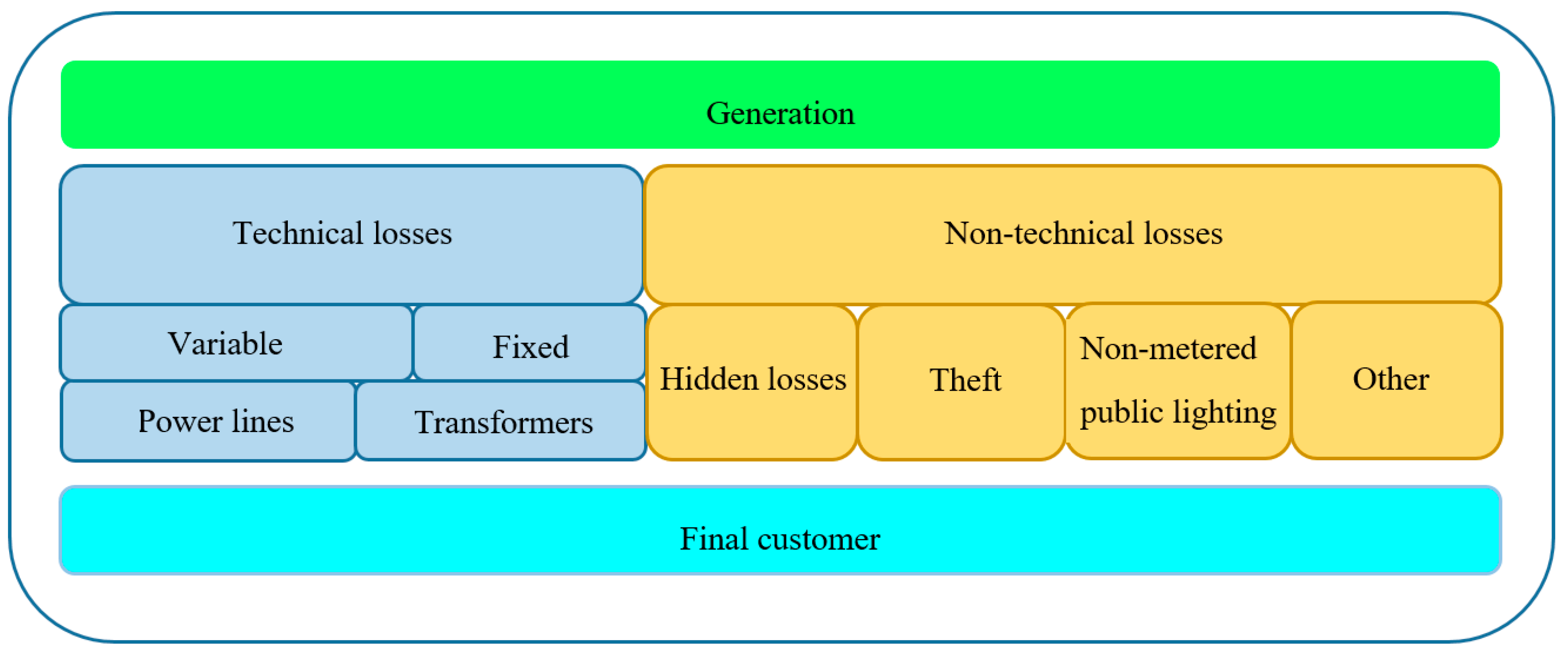
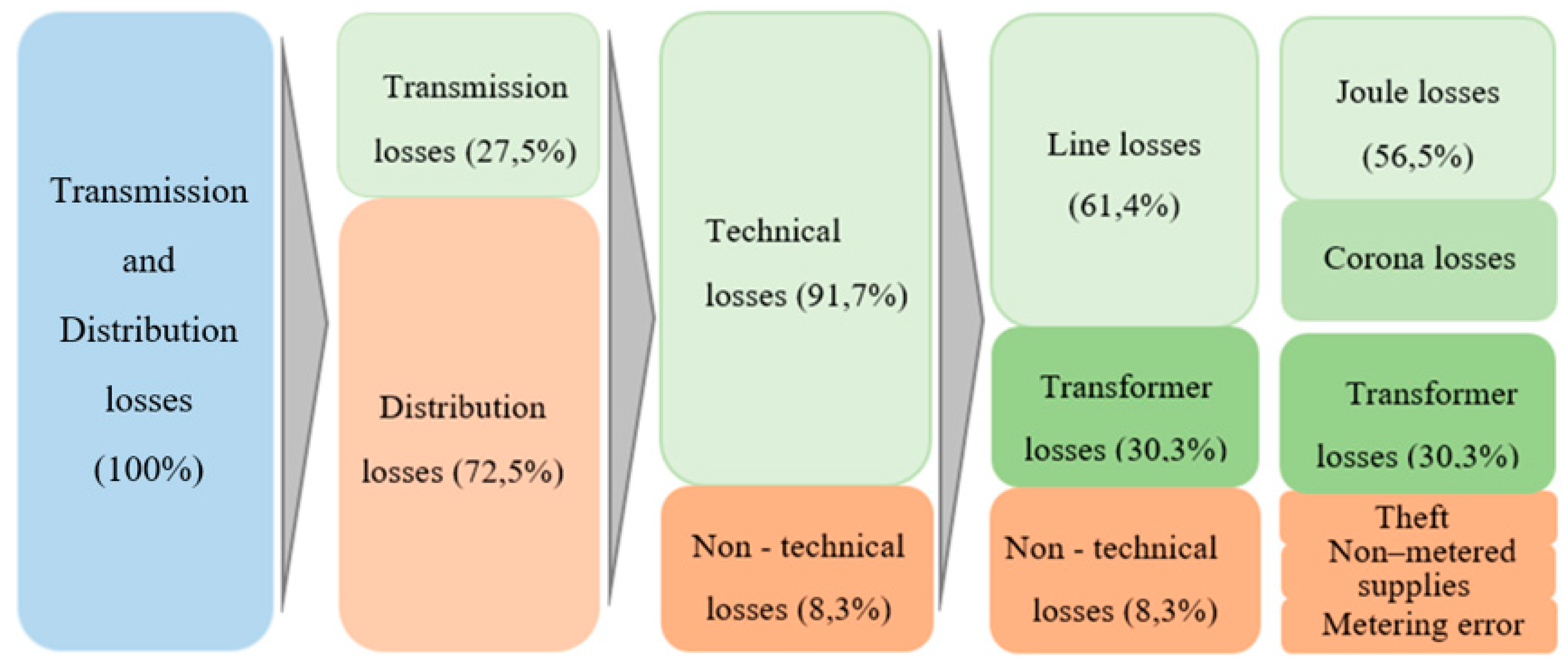


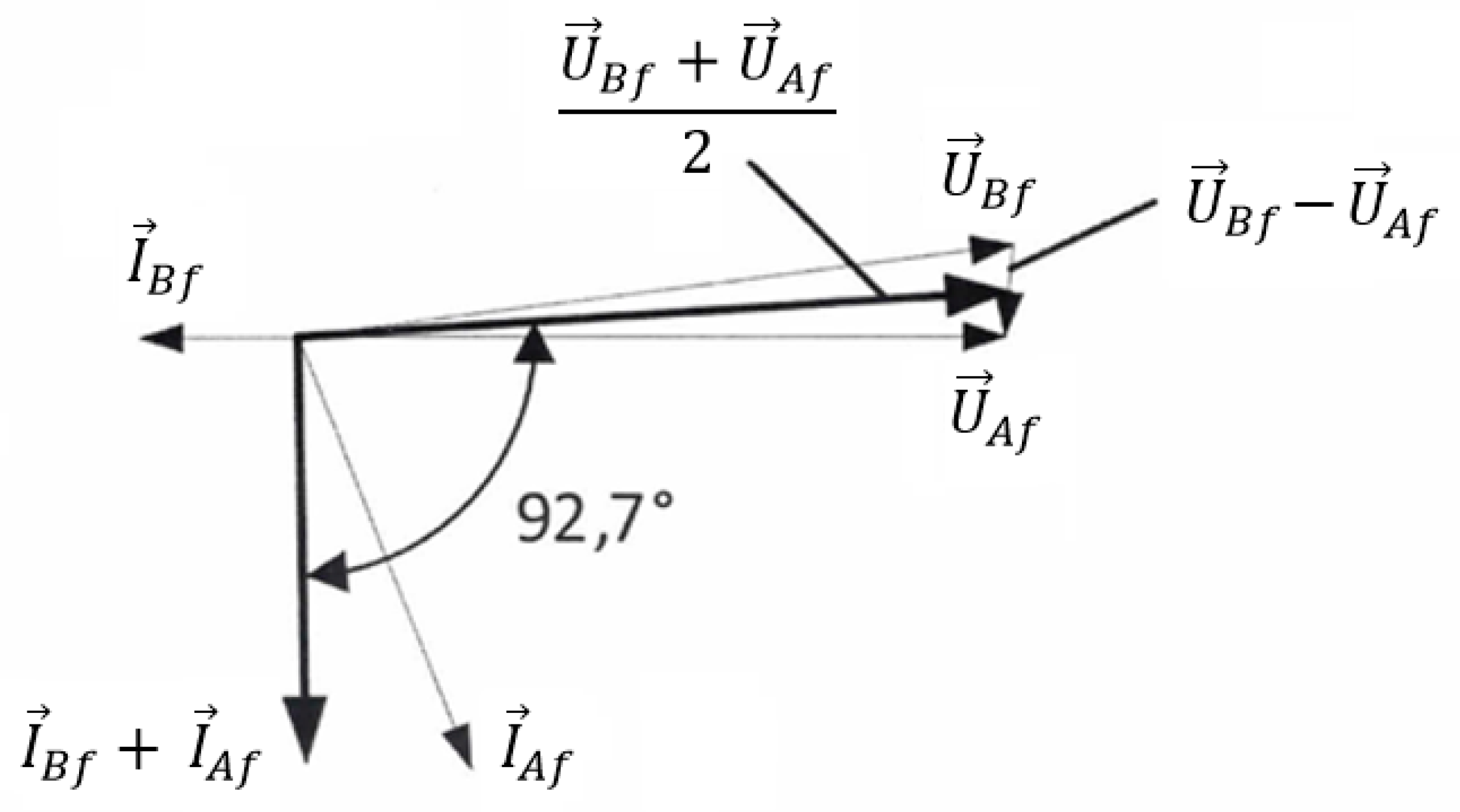
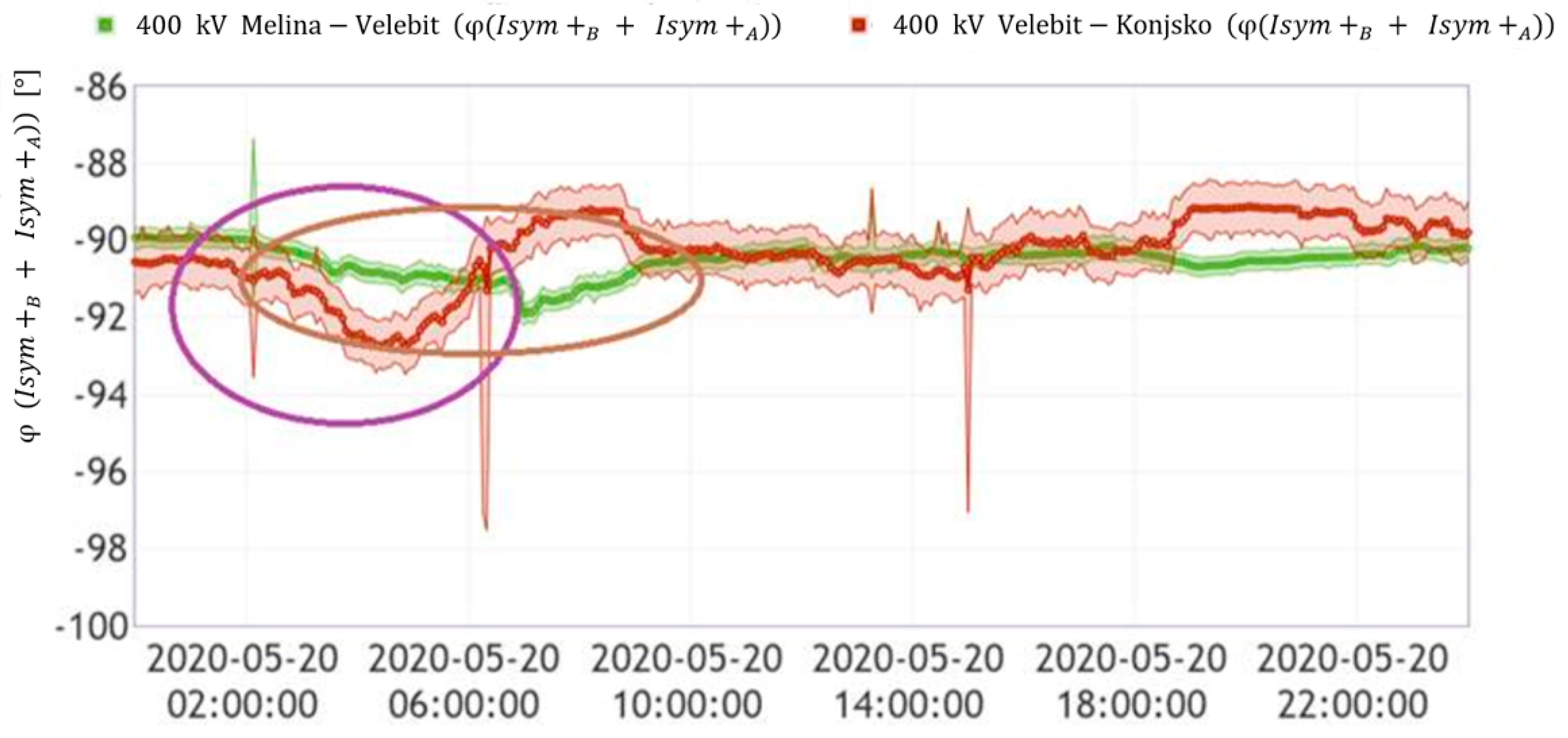


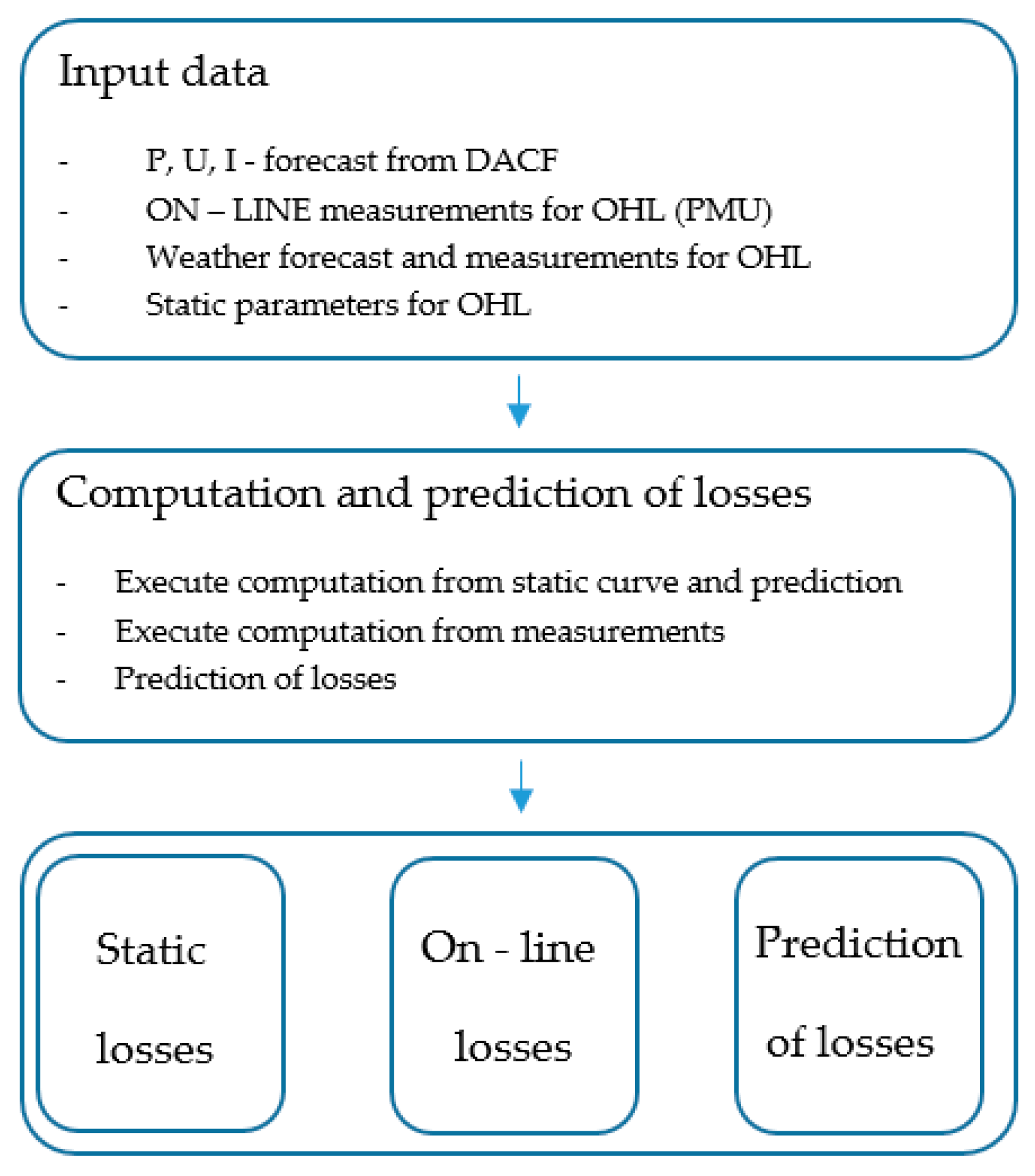
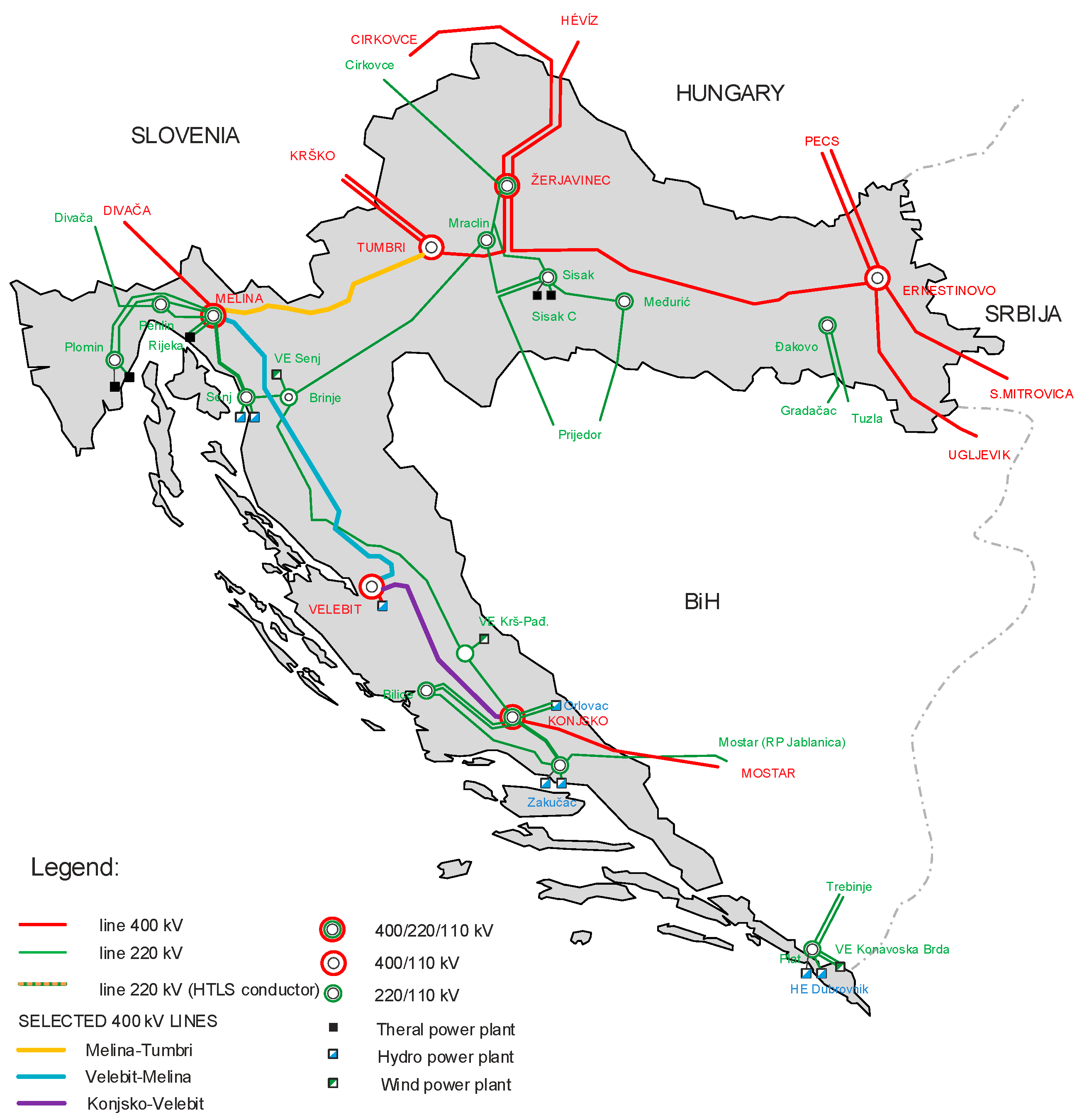
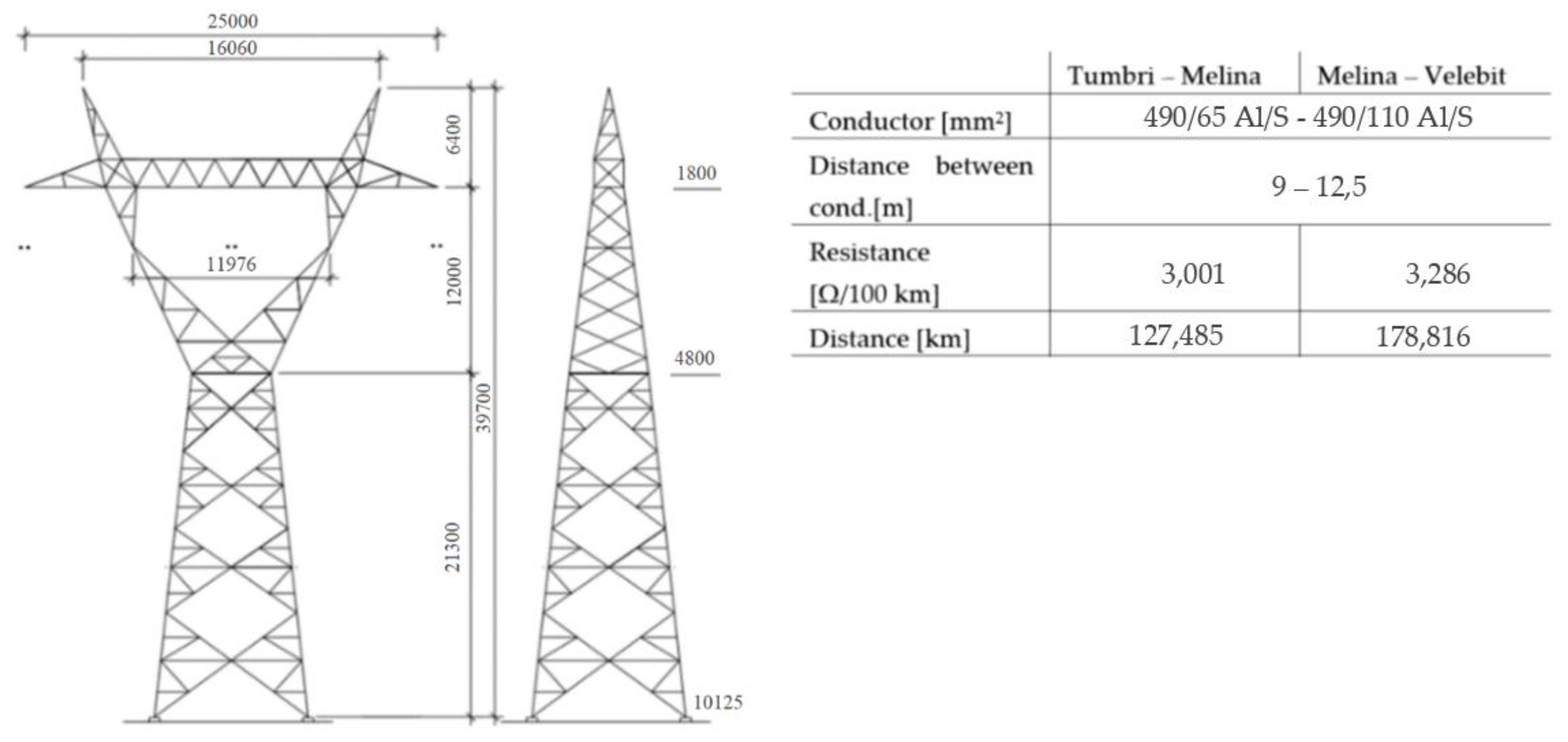

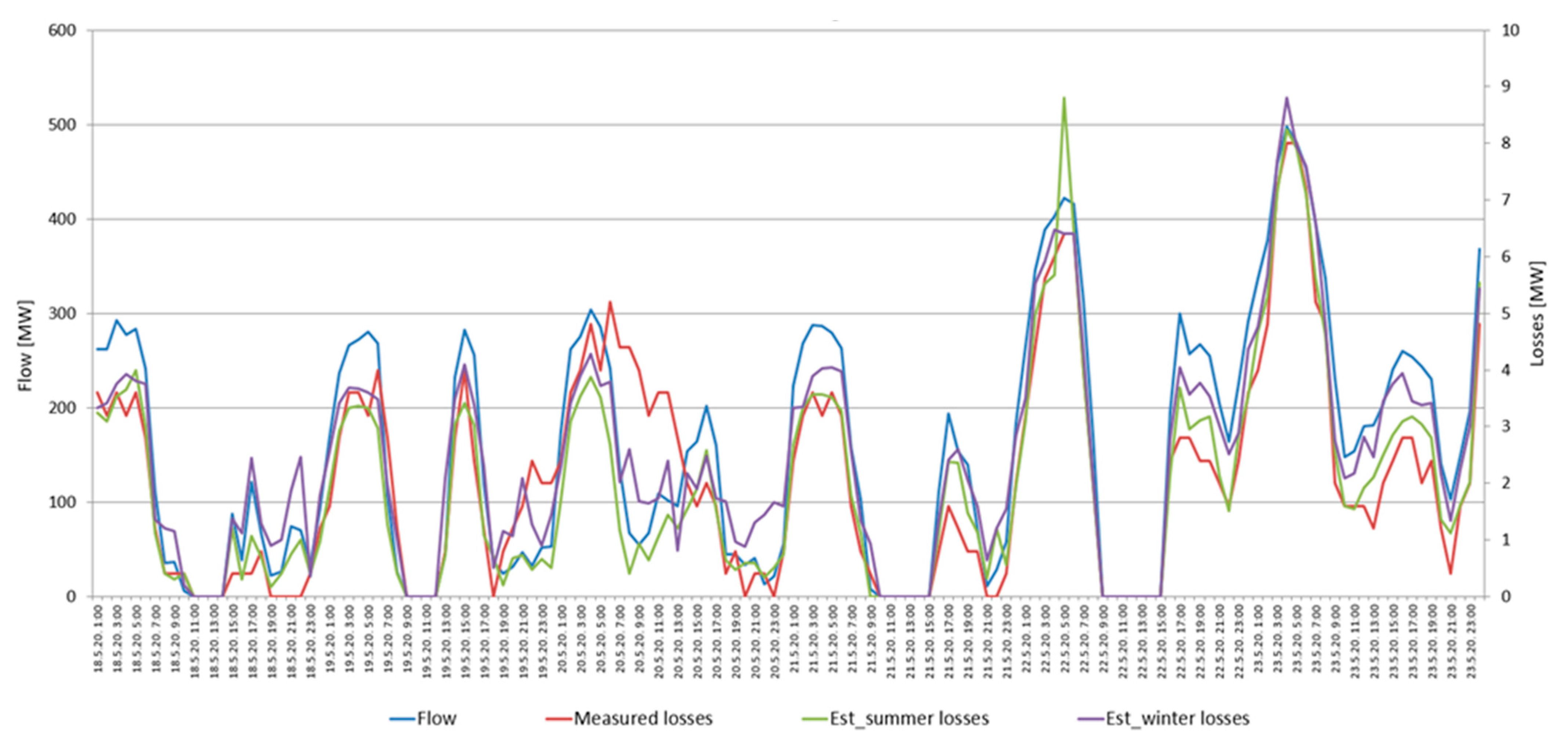
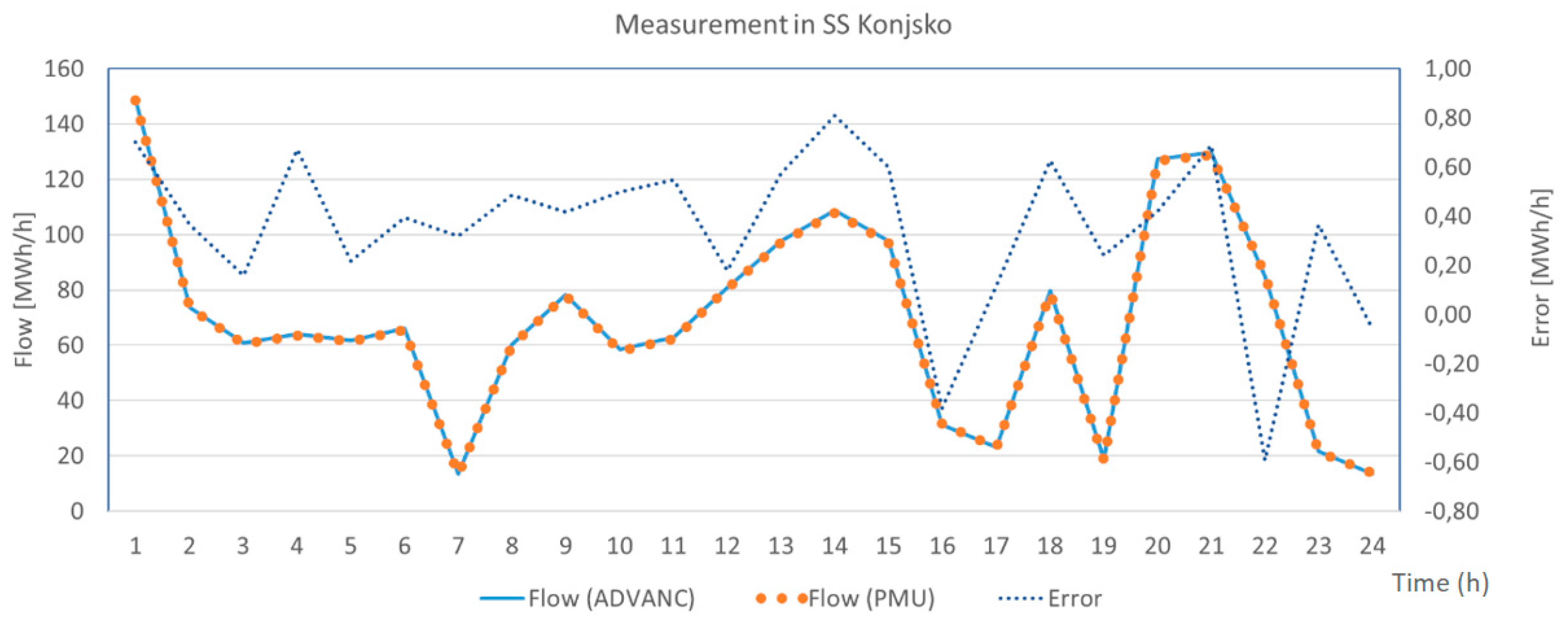

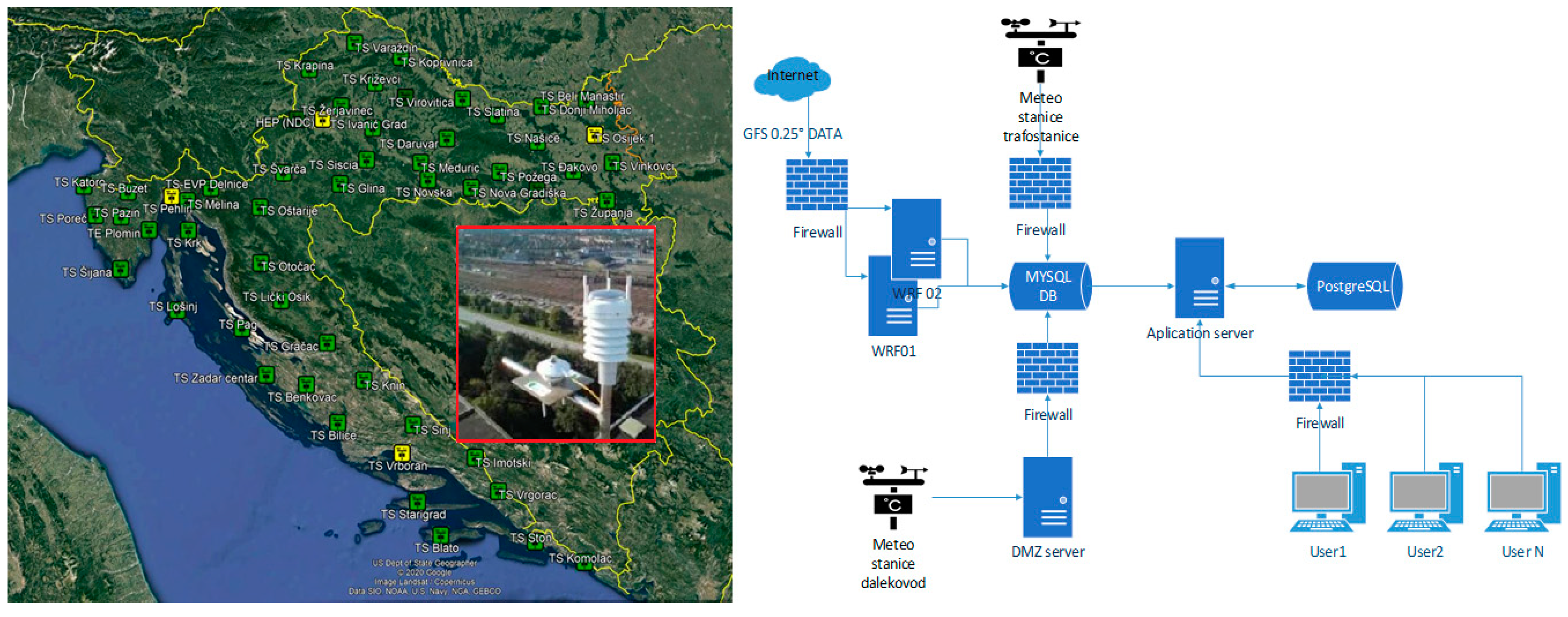

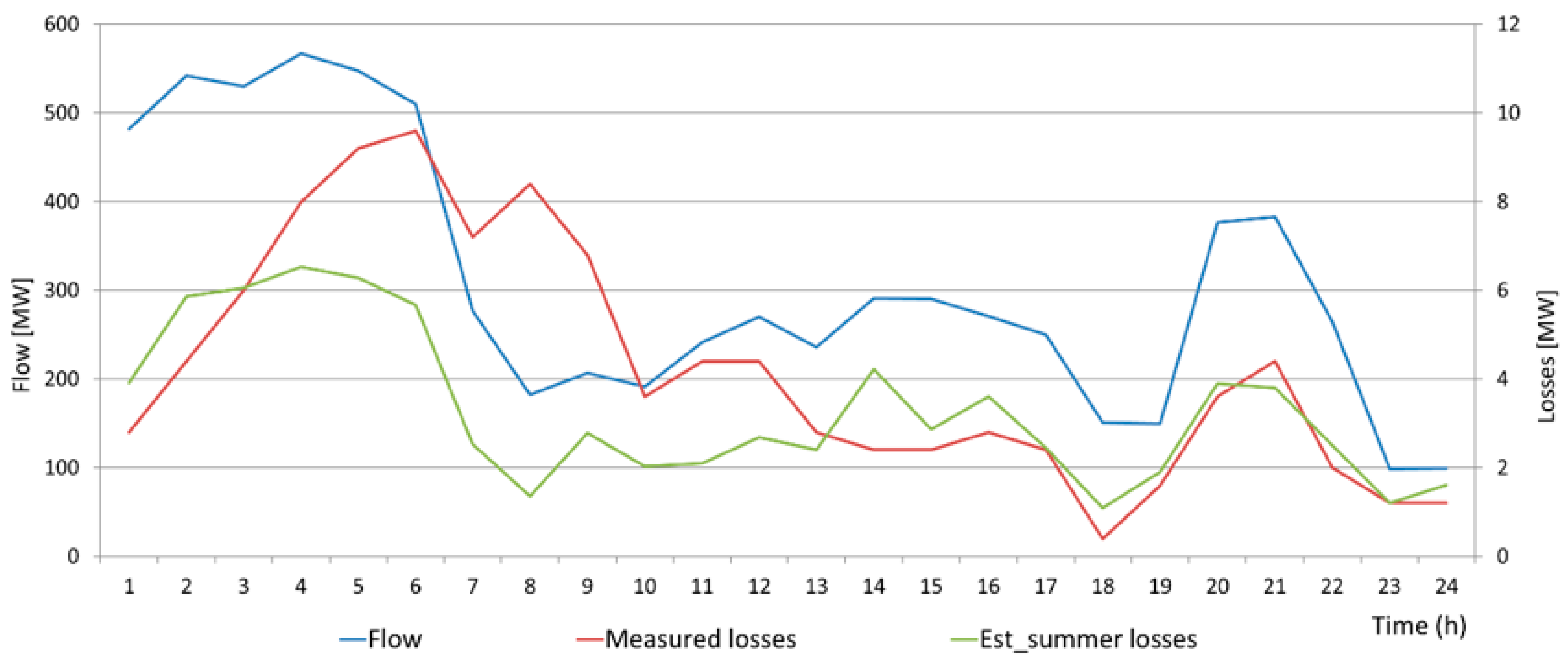
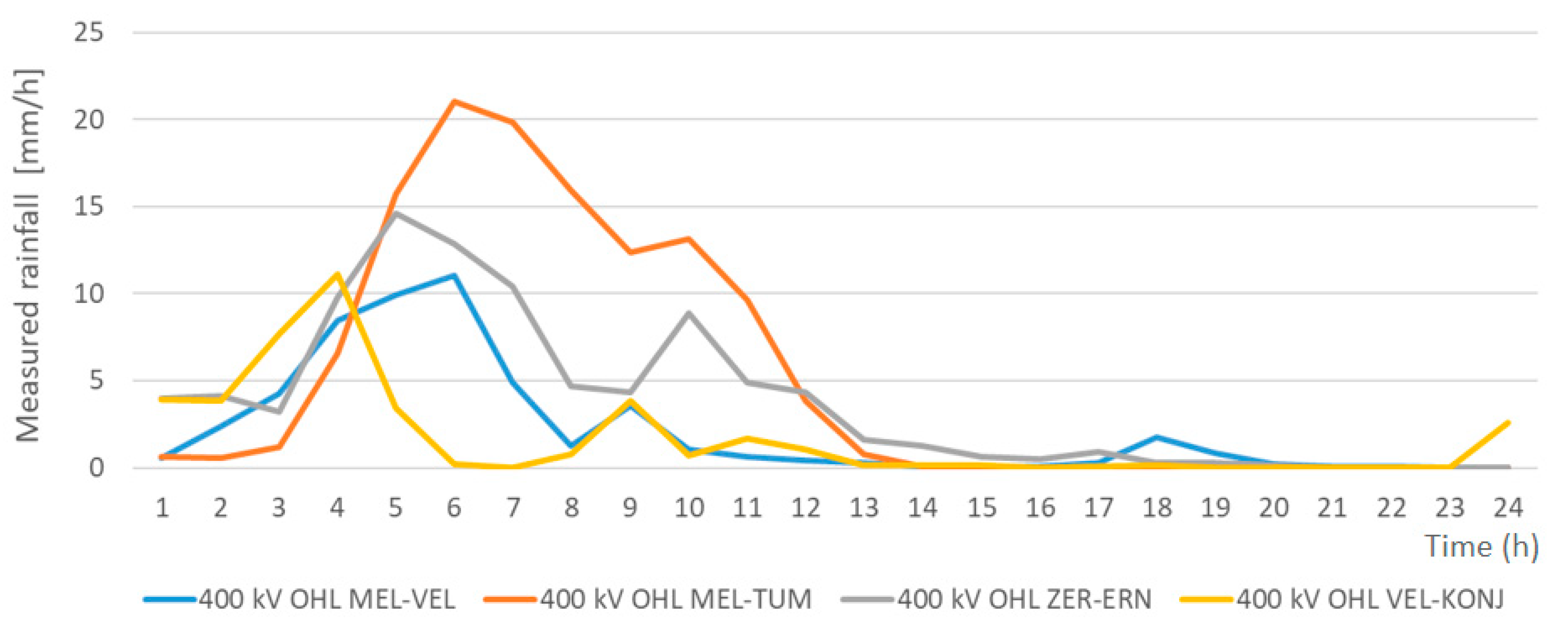
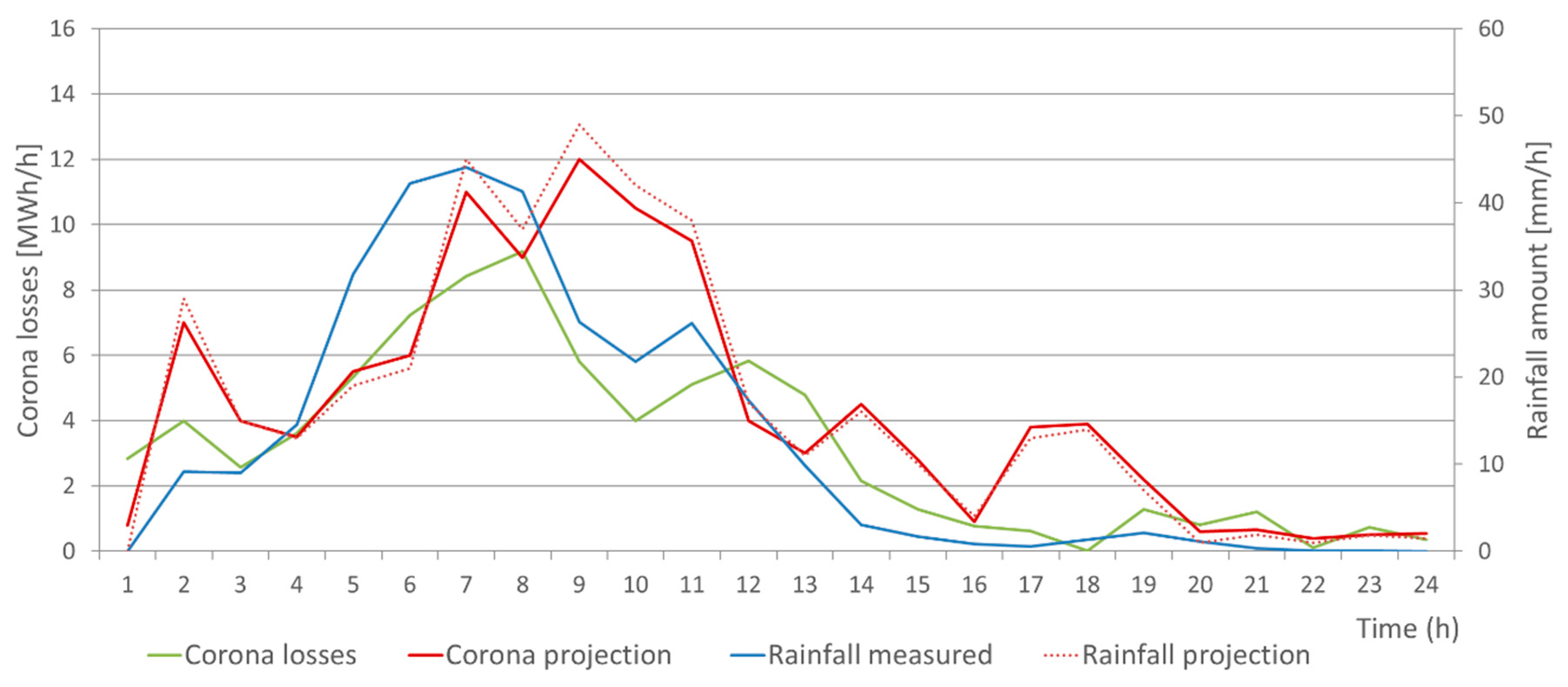
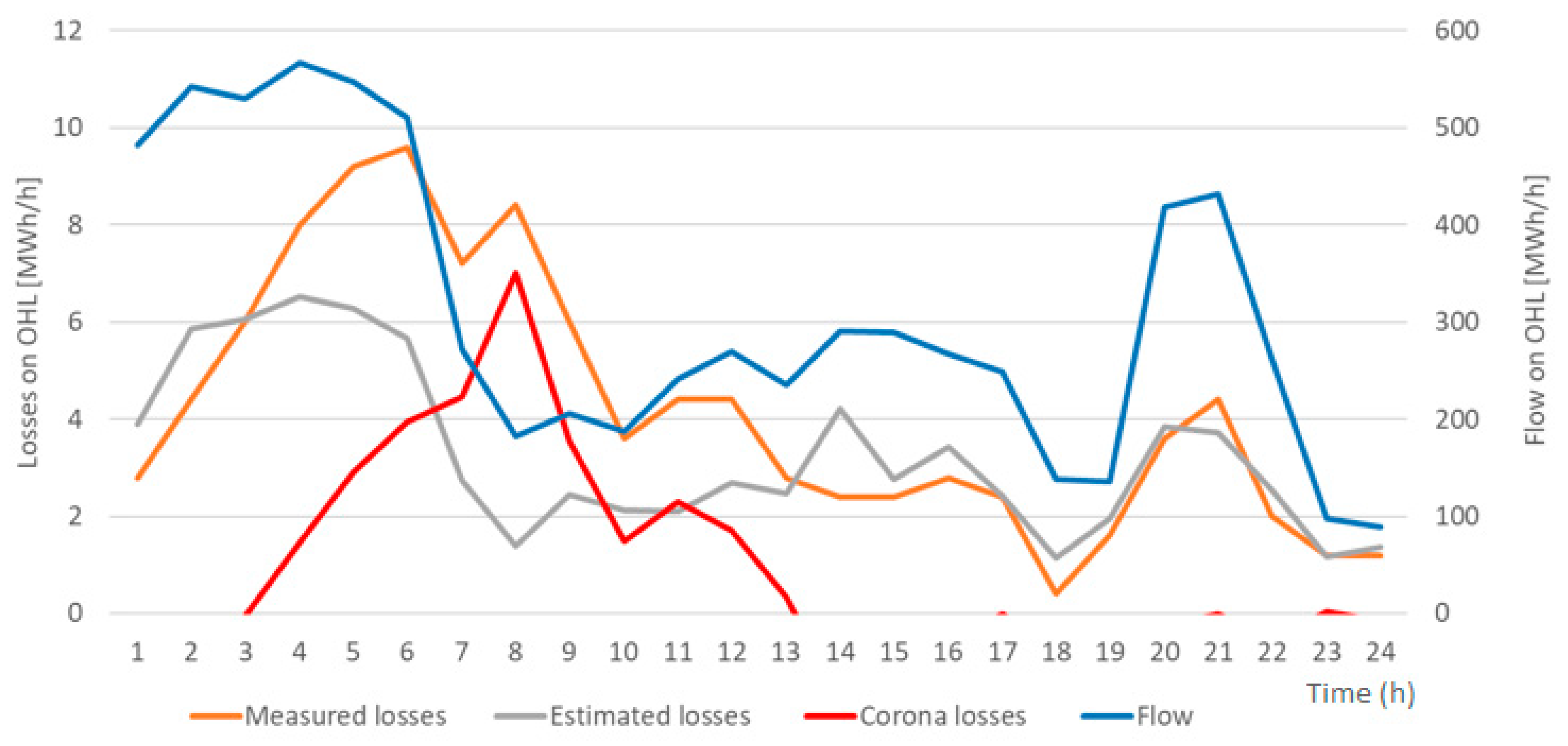
| Weather Condition Description | Corona Losses (kW/km) | |||
|---|---|---|---|---|
| 220 kV | 400 kV | |||
| 1 | 2 Conductors per Phase | 3 Conductors per Phase | ||
| 1 | Dry | 0.2 | 0.66 | 0.17 |
| 2 | Rain | - | 28.1 | 7.6 |
| 3 | Frost on conductor | - | 34.5 | 13.5 |
| Weather Condition | Losses on Insulators (W/insul.) | ||
|---|---|---|---|
| 220 kV | 400 kV | ||
| 1 | Dry | 0.1 | 0.3 |
| 2 | Light fog | 0.15 | 0.5 |
| 3 | Snow below 0 °C | 0.25 | 0.8 |
| 4 | Heavy rain | 1 | 3.2 |
| 5 | Heavy continuous rain | 1.1 | 3.6 |
| 6 | Storm | 1.5 | 4.9 |
| 7 | Rain with heavy snow | 2.2 | 7.1 |
Publisher’s Note: MDPI stays neutral with regard to jurisdictional claims in published maps and institutional affiliations. |
© 2021 by the authors. Licensee MDPI, Basel, Switzerland. This article is an open access article distributed under the terms and conditions of the Creative Commons Attribution (CC BY) license (https://creativecommons.org/licenses/by/4.0/).
Share and Cite
Pavičić, I.; Holjevac, N.; Ivanković, I.; Brnobić, D. Model for 400 kV Transmission Line Power Loss Assessment Using the PMU Measurements. Energies 2021, 14, 5562. https://doi.org/10.3390/en14175562
Pavičić I, Holjevac N, Ivanković I, Brnobić D. Model for 400 kV Transmission Line Power Loss Assessment Using the PMU Measurements. Energies. 2021; 14(17):5562. https://doi.org/10.3390/en14175562
Chicago/Turabian StylePavičić, Ivan, Ninoslav Holjevac, Igor Ivanković, and Dalibor Brnobić. 2021. "Model for 400 kV Transmission Line Power Loss Assessment Using the PMU Measurements" Energies 14, no. 17: 5562. https://doi.org/10.3390/en14175562
APA StylePavičić, I., Holjevac, N., Ivanković, I., & Brnobić, D. (2021). Model for 400 kV Transmission Line Power Loss Assessment Using the PMU Measurements. Energies, 14(17), 5562. https://doi.org/10.3390/en14175562








